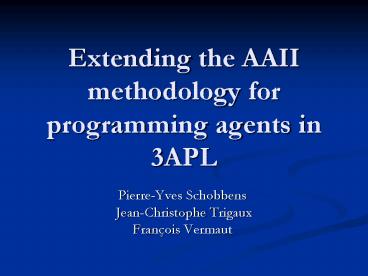Extending the AAII methodology for programming agents in 3APL - PowerPoint PPT Presentation
1 / 20
Title:
Extending the AAII methodology for programming agents in 3APL
Description:
Extending the AAII methodology for programming agents in 3APL. Pierre-Yves ... Koen Hindriks & Steven Anker. 3APL = ' An Abstract Agent Programming Language ' ... – PowerPoint PPT presentation
Number of Views:41
Avg rating:3.0/5.0
Title: Extending the AAII methodology for programming agents in 3APL
1
Extending the AAII methodology for programming
agents in 3APL
- Pierre-Yves Schobbens
- Jean-Christophe Trigaux
- François Vermaut
2
- Aim Provide a method to translate AAII models
into 3APL agent specifications. - Plan
- 1) Introduce the AAII methodology and the 3APL
language - 2) Transform AAII model into 3APL structures
- 3) Interaction model for the AAII methodology
3
AAII - Methodology
- External viewpoint
- Agent model
- Interaction model
- Internal viewpoint
- Belief model
- Goal model
- Plan model
4
AAII Agent model
- Based on UMLs class diagram notation
- Types instances
- Belief-state-set goal-state-set
- Initial-belief-set initial-goal-set
5
AAII Interaction model
- No standard notation
- ? users choice
- MSC HMSC notation from MAS-CommonKADS
6
AAII Belief model
7
AAII Goal model
- Expressed with predicates of the FOL with modal
operators (achieve(X), test(X), verify(X)) - Directly linked to a belief
- 3 Types
- Achievement goals
- Test goals
- Verify goals
8
AAII Plan model
- Based on UMLs statechart notation
- Plan nodes transitions
- 3 types of nodes
- Start nodes
- Internal nodes
- End nodes (success, fail)
- Transition triggered by an event, if a certain
condition is satisfied
9
AAII Plan model example
10
3APL - language
- Koen Hindriks Steven Anker
- 3APL An Abstract Agent
Programming Language - Based on BDI theory
- Originalities
- Combine logic and imperative programming
- Pratical reasoning rules (PR-rules)
11
3APL-Agent
12
3APL Agent Specifications
- Belief
- ? Formula of the FOL
- Basic Actions
- ? ? ? ?
- Goals
- Bact ? Goal
- Atom ? Goal
- If ? ? Beliefs, then ?? ? Goal
- If ?1, ?2 ? Goal, then (?1?2), (?1?2),
(?1?2) ? Goal - PR-rules
- head ? guard body
13
Beliefs goals derivation (1)
- Beliefs Derivation
- AAII Initial-belief-set ? 3APL beliefBase
- Syntactic equivalence (predicate of the FOL)
- Semantic difference
- AAII beliefs use trivalent logic ltgt 3APL beliefs
use boolean logic - Solution
- Limit AAII beliefs to boolean logic
- Goals Derivation
- AAII achievement or test goals ? 3APL achievement
or test goals - Syntactic differences
- Modal operators in AAII goals
- Only ? in 3APL test goals
14
Beliefs goals derivation (2)
- Semantic differences
- AAII goals make belief true ltgt 3APL goals
- AAII achievement goals trigger a plan if
associated belief is false - ltgt 3APL goals PR-rules
- Solutions
- In 3APL, explicitly assert corresponding belief
of a goal when the activated plan succeeds. - In 3APL, abort the execution of a PR-rule if the
associated belief is true.
15
Plan derivation(1)
- AAII plans are based on UMLs statechart notation
- AAII plans transitions ? 3APL PR-rule
- AAII plans events (goals) ? 3APL goals in the
head of - the PR-rule
- AAII plans actions ? 3APL goals in the body
of the PR-rule
16
Plan derivation(2)
- 3APL PR-rules store less information than AAII
plans - AAII plans are splitted into several PR-rules
17
Interaction modeling
- No standard notation
- MSC ? model simple communication between agents
- HMSC ? model higher level protocols
18
Interaction model derivation(1)
- Messages from MSC diagrams ? 3APL beliefs
- Message events (received message) ? Waiting for
the corresponding belief to become true - Sending a message ? Asserting a belief in
receivers beliefBase
19
Interaction model derivation(2)
20
Contributions
- Implement 3APL agents at a higher level of
abstraction - Extend AAII methodology with MSC and HMSC as
interaction model - Bridge the gap between agent systems modeling and
agent systems programming. - Study case in the e-Business domain
Future works
- Develop a tool based on this method































